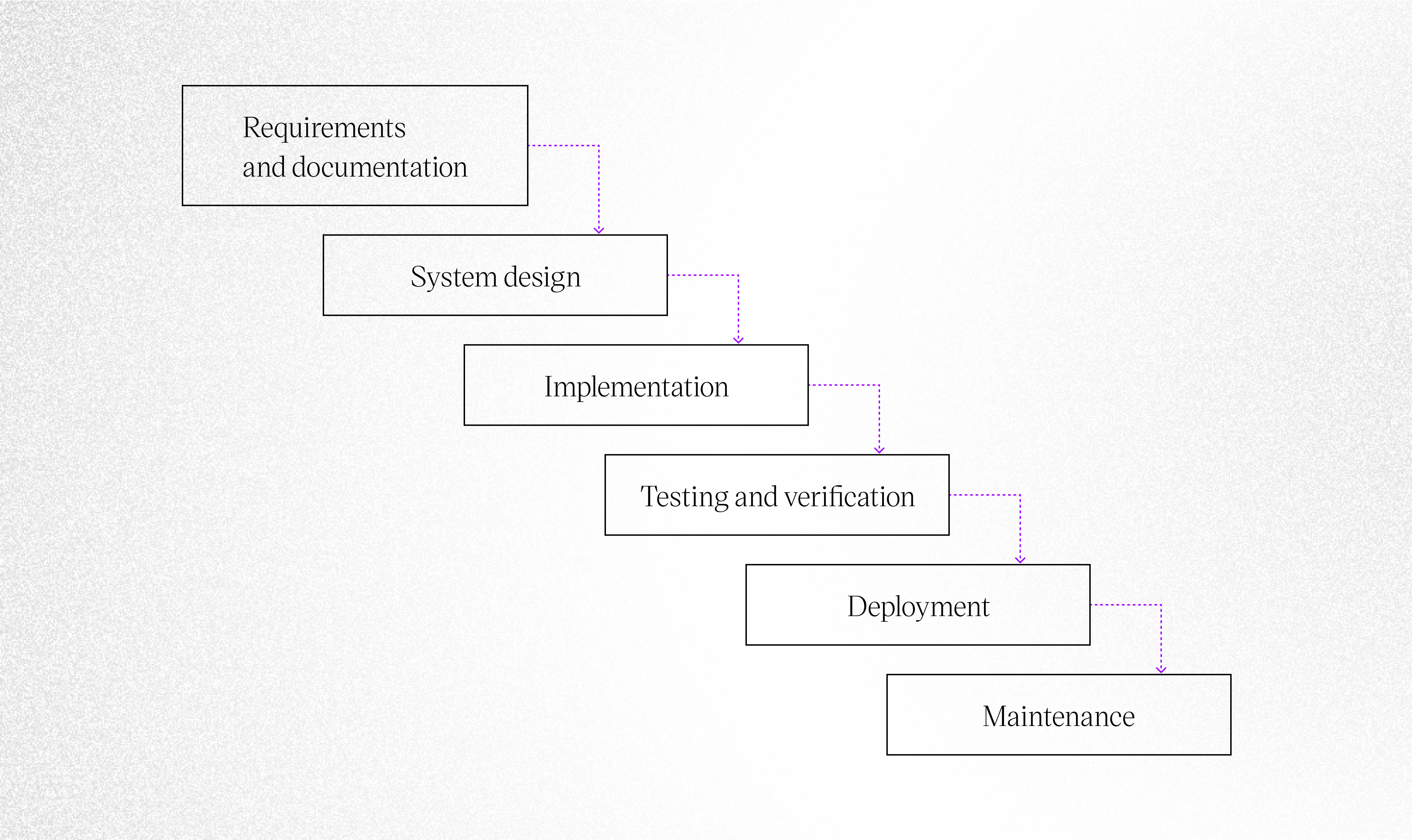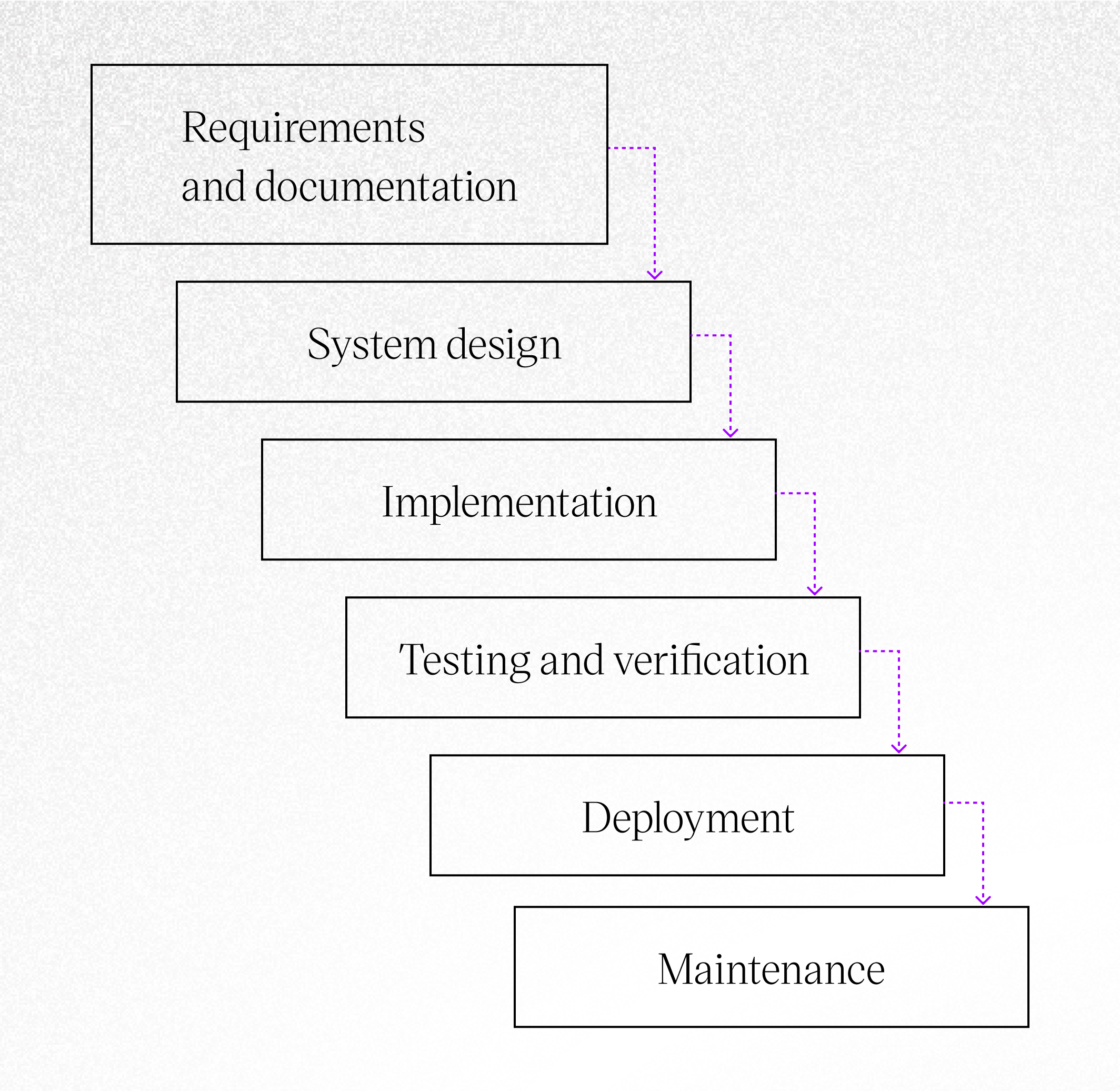November 30th, 2022 | by CSHARK
Diving Deep into Waterfall Project Management. Waterfall Methodology Guide

Table of contents
When introducing a new project idea to your team, one of the first things to decide is how to go about executing it.
There are several approaches you can take. Conducting a Waterfall project management plan is the best choice for a well-defined process in which the budget, design, and completion time are all known upfront.
In its simplest form, Waterfall methodology is a sequential approach to project management that prioritizes in-depth preparation, meticulous record-keeping, and systematic action.
This article shall comprehensively answer the ‘What is waterfall project management?’ question, so when it comes to selecting a management strategy for your next major project, you’ll have all the basics covered.
What you’ll learn from this article?
- What Is Waterfall Project Management? Starting from the basics – we’ll explain its systematic approach while breaking down its components into easily digestible chunks.
- Two Scenarios Where A Waterfall Project Management Plan is a Good Fit. Here we’ll be looking at how two different industries have benefited from the Waterfall project management plan’s streamlined approach.
- Alternatives to the Waterfall Project Management Methodology. Don’t get the wrong idea that the Waterfall method is all that exists. Here, we’ll skim the surface of the Agile methodology, including the Scrum and Kanban frameworks.
- The Pros and Cons of Conducting a Waterfall project management plan. What better way to make an educated choice than to evaluate the pros and cons?
What’s Waterfall Project Management?
If you want precise and satisfying results from your project’s execution, you’ll need a methodical, step-by-step approach to management from start to finish. The Waterfall methodology is a sequential approach to project management in which requirements from stakeholders and customers are gathered at the outset and then incorporated into the project plan in a linear fashion.
The name “waterfall model” comes from the way that each successive stage of the project naturally flows into the next. The software development life cycle, sometimes known as the SDLC, is widely used in the fields of software engineering and product design, and the Waterfall project management plan is a central tenet of this framework. It helps everyone on the software development team know their roles and the timeline for completing tasks.
To prevent confusion and project failure, the model clearly outlines entry and exit criteria for each phase. Each stage must be finalized before moving on to the next. In a nutshell, the Waterfall approach eliminates the possibility of overlap.
In contrast to the iterative and incremental approach taken by the Agile methodology, the Waterfall method bases its pillars on fixed rules and procedures. This makes smaller projects with well-defined requirements and little need for frequent modification ideal for the Waterfall paradigm. The strategy is very organized and each step has clear boundaries that anyone can understand.
The Steps Behind A Waterfall Project Management Plan
Let’s examine the processes that go into putting a Waterfall project management plan into action.
The Steps of Waterfall Project Management Plan


Requirements and Documentation
The primary target during this phase is to collect all the information and materials needed to begin the project. This will allow you to establish the work’s scope, including the project’s functional requirements, deliverables, features, deadlines, expenses, and so on.
In this stage, you will also conduct interviews and gather data to assess stakeholder expectations and gain a thorough understanding of the requirements. Competitor analysis, consumer insight, and market segmentation are all crucial aspects of this phase since they will inform your team’s recruitment and resource allocation decisions.
System Design
After covering all the groundwork, assembling the required documents, and putting together a team, the next stage is to develop a system design that will serve as the basis for the final product.
An essential part of developing such an architecture is identifying and documenting all the steps involved in creating the final product. If you’re aiming for maximum efficiency, take some time to develop a thorough timeline to understand better how much time should be spent on each of these steps.
Implementation
After finalizing the blueprint, the technical implementation phase can begin!
Since there has already been so much groundwork in the Waterfall project management plan’s research and design phases, this step may be the quickest. Software developers or programmers create the underlying code for an application based on the project’s needs, specifications, and designs. The implementation phase includes steps like keeping tabs on the project’s development to ensure it’s on track, allocating time and resources where they’re most required, and keeping the client, customer, or other stakeholders in the loop.
Testing and Verification
With the waterfall method, the following phase entails checking and rechecking the project’s specifications. Starting with a quality assurance testing plan, team members document and report any problems they encounter. When the testing phase is complete, the team guarantees the product is up to par with what the client or consumer expected. In addition to finishing up any remaining documentation and filing it away, this stage also involves making a template of the project that your team can use for forthcoming comparable projects or initiatives.
Deployment
When a product or program has been tested and found to work as intended, it is ready to be released into a production setting. Deployment encompasses all activities necessary to bring the entire system live for the end user or client, including installation, migration, and ongoing maintenance. In this phase, you will ensure everything is working smoothly and verify that your tests meet the exit criteria.
Maintenance
Providing excellent maintenance and routine checks for your clientele is the backbone of every product development cycle. More often than not, the final product would require continual updates and enhancements through remedial, responsive, and promotive maintenance.
2 Scenarios Where a Waterfall Project Management Plan is a Good Fit
A Waterfall project management plan is a tried-and-true system that has stood the test of time because of its comprehensiveness and structure. The construction, information technology, and software development sectors are only a few examples of commonplace Waterfall model usage.
Let’s look at two cases where a Waterfall approach to project management is a good fit.
1. Healthcare Management
In addition to the sheer size of the healthcare industry, several variables contribute to project management’s significance in the sector. Patient care stakes are incredibly high, especially during challenging periods like the Covid-19 Pandemic. Healthcare managers and the numerous parties involved in medical interactions benefit from using the Waterfall project management plan because it simplifies and standardizes activities like maintaining electronic health records and regulatory limits related to patient safety and the quality of care.
2. Construction Management
Every aspect of a construction project, from the smallest home renovation to the tallest skyscraper, needs a well-organized timeline with milestones, due dates, deliverables, and client expectations. Its success may trace back to the waterfall approach to project management, which involves the technical aspects of planning and implementation but also incorporates a human element by requiring project managers to meet the various needs of the project’s builders, stakeholders, and community members.
Building a house from the ground up, including laying the foundation, framing the walls, and installing the roof, is an example of a Waterfall project management plan in the construction sector that can benefit from the method’s linear and sequential approach. Finishing the current phase is the only way you can move on to the next; in this case, you can only put in windows after finalizing building the walls.
Alternatives to the Waterfall Project Management Methodology
The Waterfall approach works best for well-defined projects that benefit from extensive documentation, precise requirements, ample resources, and a well-defined schedule. In addition, this method shines when both the end goal and the client’s expectations for the project’s scope are crystal clear.
Say your team prefers short iterative cycles over extensive design and planning-heavy Waterfall project management plans. Then, the Agile methodology might be the best alternative.
Scrum is one of the most well-known and extensively adopted Agile frameworks, basing the project’s plan on short periods of time called “sprints,” which can span anywhere from two weeks to a whole month. The Kanban method is another option; it’s a framework built on several Agile principles and shares many of Scrum’s core objectives. Compared to other software development methods, Kanban stands out due to its emphasis on visual management.
The Pros And Cons Of Conducting A Waterfall Project Management Plan
The Waterfall methodology is a tried and tested approach to managing projects with a successful track record due to its clear structure and logical process.
Let’s look at some of the advantages of inculcating this method:
- Structured Approach: The Waterfall project management plan avoids chaos and inconsistency by breaking the project down into structured, manageable chunks.
- Simplicity via Documentation: A well-documented, well-planned approach makes it simple for huge teams to keep in the loop while they work toward a common goal.
- Clearly Defined Timeline: There is no room for guesswork when it comes to tracking development because milestones, project costs, schedules, and deadlines are all laid out in fine detail.
- Time-Saving: The key advantage of this method is that plans can be easily streamlined and recycled from previous projects with minor tweaks, saving a lot of time.
- Encourages Careful Analysis: During the analysis and design phases, developers are better able to spot design flaws, which in turn reduces the likelihood of producing faulty work during the development phase.
As with everything else, such an approach comes with its own set of flaws. Let’s understand some of the cons of using the Waterfall model:
- Lack Of Flexibility: Due to the method’s dependence on sticking to a predetermined course, there is a high degree of uncertainty and risk whenever there is a change or modification to the requirements midway through the model’s actual implementation. In such circumstances, Agile, or a combination of the Agile and the Waterfall method, is a good option.
- Not Suited For Complex Projects: This paradigm is unsuitable for larger, more complicated projects, particularly when specifications are rapidly changing.
- No Feedback During The Development Stage: This method does not account for the possibility of acquiring useful, actionable user or client input in the middle of the process and adjusting accordingly, meaning that adjustments can only be made at the very end when they are far more challenging to implement.
Conclusion
The Waterfall model is a method of project management that takes a systematic and organized strategy and mandates that you adhere to stringent deadlines in order to produce a high-quality end product.
Virtually any kind of development procedure can benefit from this, including those involving complicated work or a lot of output.
Keep in mind that such an approach works best for endeavors requiring linear rather than fluid steps to be completed.
We’ll help you understand the waterfall model. If you have any questions or thoughts, drop us a line.


